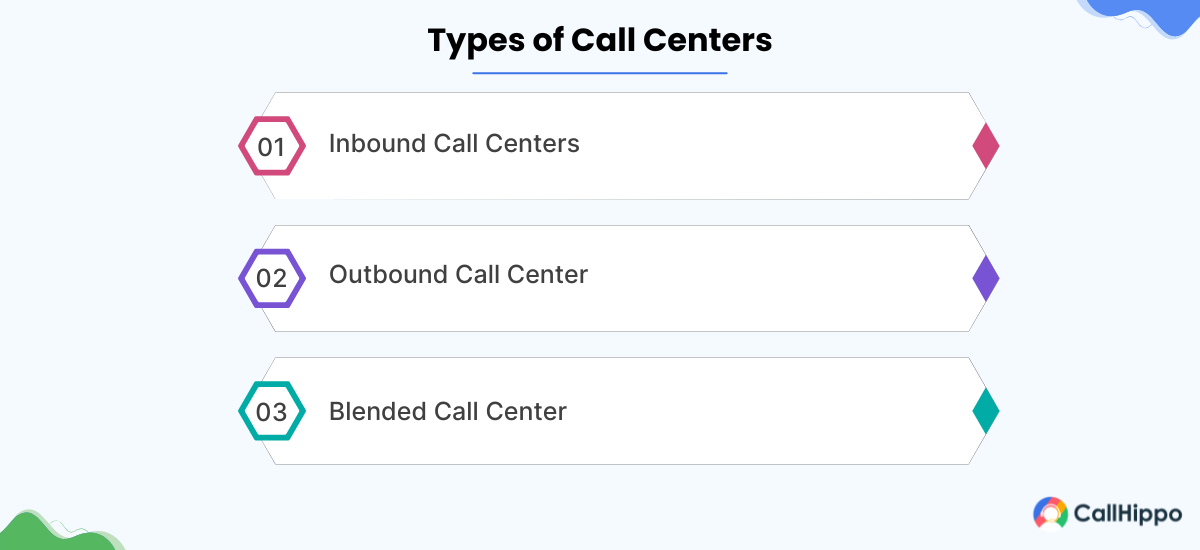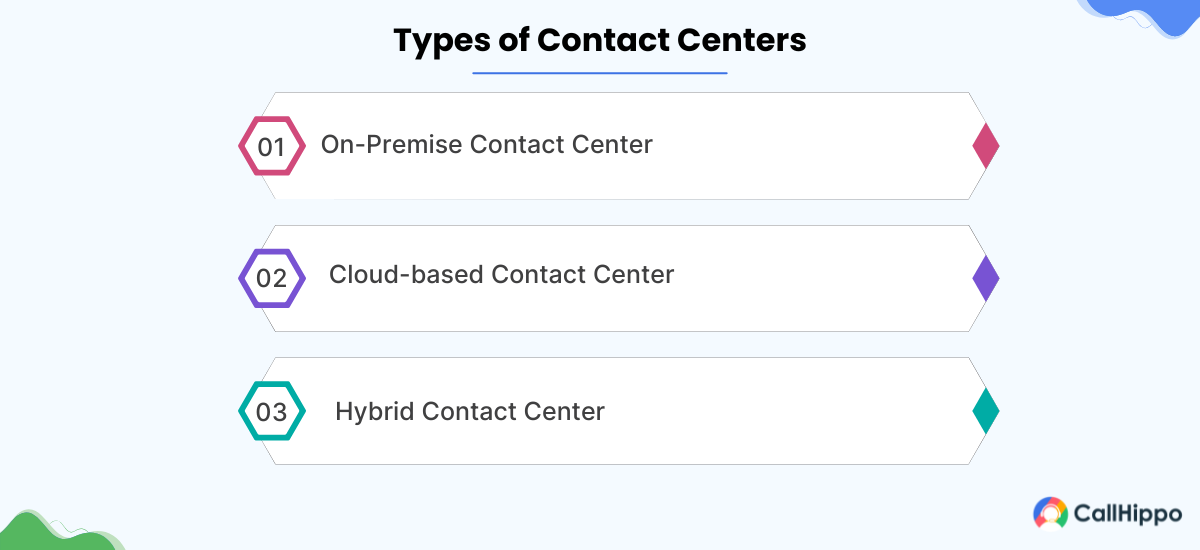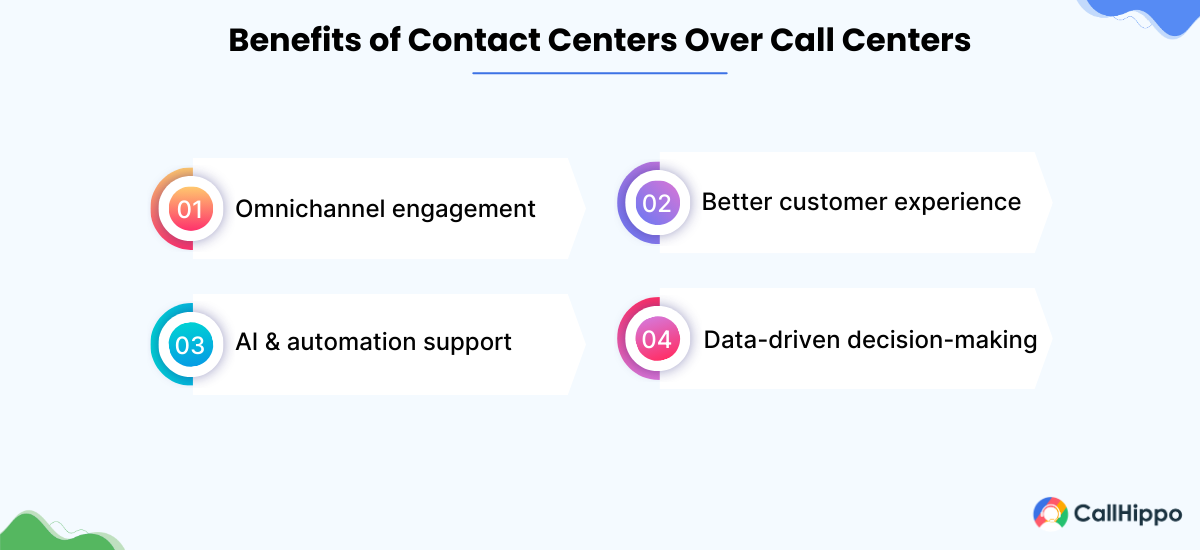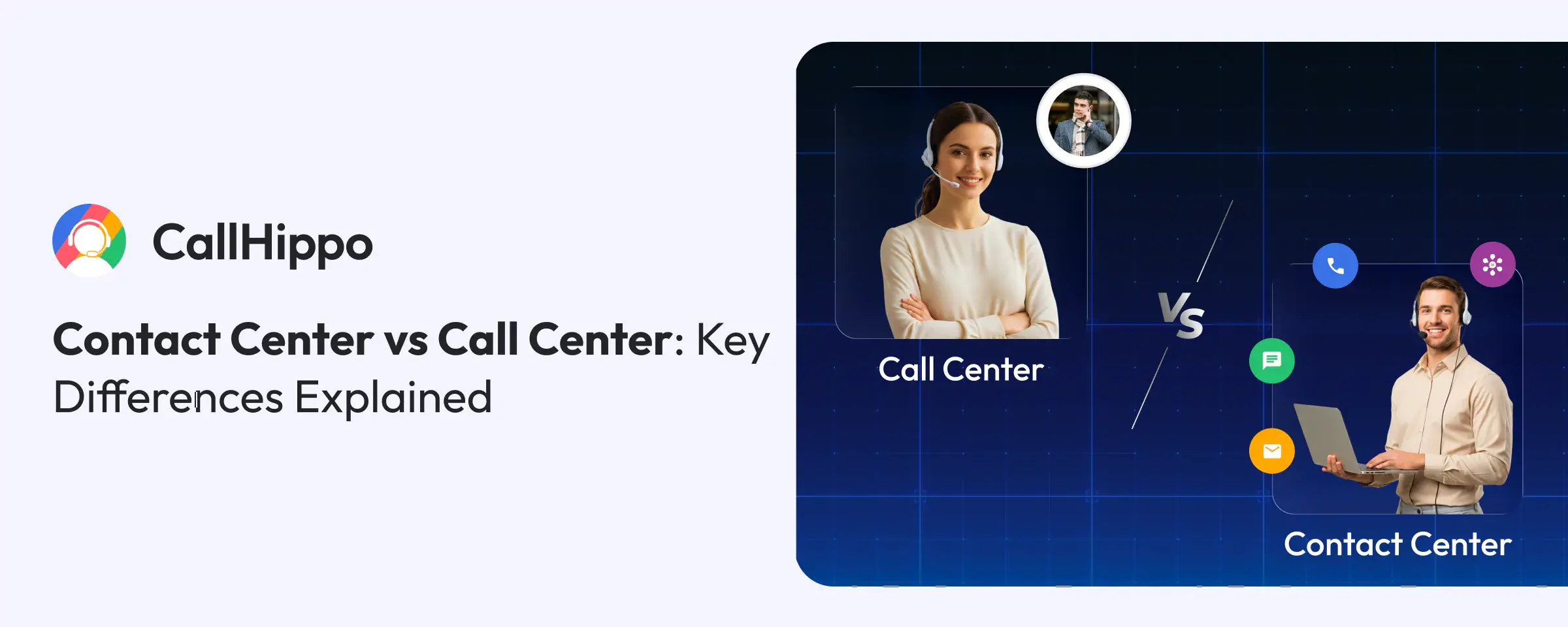Having spent years deep in the world of customer service tech, I can tell you the ‘contact center vs. call center’ debate is often overcomplicated.
A call center manages phone calls while a contact center manages customer relationships. And with 90% of consumers stating that an immediate response is important when they have a customer service question, speed and accessibility are critical for both solutions.
So, in this blog, we will help you choose the right solution with an in-depth comparison between the two customer service tech.
What is a Call Center?
A call center is an office or facility that is used to receive a high volume of requests by telephone calls. Without any doubt, call centers have become the backbone of customer service and telemarketing functions. Worth mentioning, the average speed of answer in a call center is around 28 seconds. Their focus would typically only be on the management of voice-based communication, both outbound and inbound calls.
Interested in knowing more about the speed to answer calls and how to improve it?
Then read our latest blog on average speed to answer (ASA) in a call center.
Types of Call Centers
Call Centers are generally categorized by the direction of the call. Here are the major categorizations of different types of call centers.

Inbound Call Centers
Call center agents receive inbound calls from customers, such as customer service hotlines, technical support desks. They help customers with the goal of fixing any customer service issues.
Outbound Call Center
Traditional call center agents make outbound calls to customers or prospects. This type of call center can be used for telemarketing, lead generation, and debt collection.
Blended Call Center
A hybrid of both inbound and outbound blended call centers provides the maximum flexibility in a call center based on demand and agent availability. Pro Tip: A call center that is focused on specific functions – like lead qualification or debt collection – can be highly effective for businesses that have high-volume voice calls. If you are using an automated call distributor (ACD), you can set up a call center that efficiently places calls to manage inbound calls and minimize waiting times.
What is a Contact Center?
A contact center takes the existing telephone call center concept and builds on it with a more comprehensive infrastructure capable of omnichannel communications. While a contact center leverages voice calls, the scope of a contact center provides more functionalities, built on different digital capabilities.
Types of Contact Centers
Contact centers can be defined by using their specific operational model. Majorly, on-premises, cloud-based, and hybrid contact centers are preferred types of contact centers by businesses.

On-Premise Contact Center
All hardware and software are hosted locally within the company’s infrastructure. This model has been a traditional model because it offers high control but tends to be more costly to maintain or scale.
Cloud-based Contact Center
Cloud contact center solutions are hosted by a third-party provider on the cloud and accessed through the internet. This is also an evolving model of contact center technology, which is delivering flexibility, scalability, and cost-effectiveness.
Hybrid Contact Center
It is a model that blends both a cloud-based solution and an on-premises solution. This is a flexible option that enables an organization to maintain a few high-level operational systems on-premises, while leveraging the cloud to manage scalable technology functions (e.g., a call center that handles customer questions from digital channels on busy days). This is a great contact center model for organizations that want to acquire cloud technology but have specific business needs.
Contact Center vs Call Center: Key Differences
Here’s a quick comparison table showing the fundamental differences between call centers and contact centers:
| Feature | Call Center | Contact Center |
|---|---|---|
| Communication Channels | Voice calls only | Omnichannel (voice, email, chat, social, SMS) |
| Technology Used | PBX, IVR systems | CRM integrations, AI chatbots, analytics |
| Customer Experience | Reactive, transactional | Proactive, personalized journeys |
| Scalability | Limited by physical infrastructure | Cloud-based, highly scalable |
| Primary Use Cases | Basic support, telemarketing | Full customer engagement, sales, retention |
Now let’s dive deeper into each of these key differences:
1. Communication Channels
Traditional call centers operate exclusively through telephone communications, handling both inbound and outbound calls. This single-channel approach often leads to longer wait times and customer frustration, as it forces all interactions into one queue without considering customer channel preferences.
Modern contact centers support a comprehensive range of communication channels, including voice, email, live chat, social media, SMS, and messaging apps. This omnichannel contact centers approach allows customers to choose their preferred method of communication.
2. Technology Used
Call centers depend on traditional technologies such as Private Branch Exchange (PBX) systems that auto attend for incoming calls and Interactive Voice Response (IVR) menus. These technologies primarily engage with routing an incoming call.
Contact centers use more sophisticated technology. They employ Customer Resource Management (CRM) integration, AI chatbots, predictive analytics, and workforce optimization capabilities. This blended technology creates a means toward a 360-degree view of the customer interactions and creates opportunities for data-driven decision-making.
3. Customer Experience
Call centers tend to be disconnected spaces and they are waiting for the customer to reach out to the company for a specific need. Most experiences are transactional. But it becomes personal only when the customer calls or engages with the agent, which requires personal engagement to resolve an issue or question.
Contact centers have omni-channel interaction capabilities where they can provide customer service proactively through data analytics and customer mapping. When a contact center exists, it means there will be personalization of experience applied when addressing a customer need, while also retaining full context from across each of the different interactions.
4. Scalability/Flexibility
Call centers are not agile or scalable because they rely on physical infrastructure. Adding a new agent to the call center may require a significant capital investment, such as computer hardware, phone line costs, extra space in a building, etc., and service. It’s difficult, and potentially costly, to scale quickly to meet demand.
Contact-center-as-a-service models provide sufficient scalability for voice and digital engagement. That means the business can adjust bandwidth or capacity up or down quickly to change demand. The cloud provides the right tech infrastructure in a much faster way to deploy engagement channels and capabilities without significant capital investment.
5. Practical Application
Call centers work well with high transactional engagements where voice interaction is the primary or only channel. Its practical applications include basic customer support hotlines, telemarketing or sales campaigns, appointment confirmations, and basic surveys where basic voice engagement is sufficient.
Contact centers work best in more comprehensive modes, seeking the full management of the customer lifecycle. Its practical applications include handling lengthy sales cycles, technology support paths for multiple contacts, customer retention programs, or companies looking for more comprehensive services.
Benefits of Contact Centers Over Call Centers
The transition from call center to contact center is driven by substantial benefits to the customer and the business. Here are the major benefits of contact centers that make them an ideal solution.

1. Omnichannel Communication
Customer expectations are always expanding, and customers expect to engage with companies on their own terms. Contact centers provide this flexibility while enhancing customer satisfaction and customer loyalty by being present and available on every digital channel.
2. Better Customer Experience
By providing a seamless, contextual, and personalized experience across every point of contact, contact centers enrich the customer experience. Moreover, they increase customer retention rates while providing insights into customer behavior through the entire customer journey.
3. AI & Automation Assistance
Modern contact center solutions utilize AI to automate repetitive parts of the interactions. They take the help of chatbots to route complex issues to customer service representatives and assist contact center agents. It leads to better utilization of resources and efficiency.
4. Data-Friendly Decision-Making
Integrating analytics gives the contact center the freedom to turn customer interactions into actionable intelligence. Contact center managers can track customer sentiment, identify common pain points, and measure agent performance across all channels.
Which Option is Right for Your Business?
Choosing between a call center and a contact center isn’t one-size-fits-all. The right fit depends on where your business stands today and how you plan to grow tomorrow.
| Business Type | Recommended Option | Why It Works |
|---|---|---|
| Small Businesses | Call Center | Handles basic inbound/outbound calls efficiently, is cost-effective for limited customer interactions, and is easier to manage with a small team. |
| Growth-Focused & Customer-First Brands | Contact Center | Offers multi-channel support (calls, chat, email, social), improves customer experience, and scales with business growth. |
| Decision-Making Tips | Depends on Budget, Goals & Customer Base Size | Lower budget & small customer base should choose a call center. Larger customer base, higher service expectations, and long-term growth plans should be considered when choosing a contact center. |
If you’re unsure whether to stick with a call center or upgrade to a contact center, run a 3-month channel preference analysis. Track how customers reach out today and project how those trends will grow. This helps you base the decision on clear ROI rather than guesswork.
Best Practices for Transitioning from Call Center to Contact Center
Moving from a call center to a fully operational contact center is more than just a technology transfer. It’s a strategy change. Creating a successful transition begins with a plan for balancing technology, people, and customer experience, all without overloading your staff or breaking the budget.
Assess Current Infrastructure and Gaps: Understand where you are starting by mapping what currently exists in systems and the gaps for possible system integration.
Plan your Omnichannel Integration: Begin with 2-3 of the most requested channels and use forward-thinking planning to ensure that there is seamless conversation continuity between all the channels included.
Invest in Scalable Cloud Solutions: Choose scalable CCaaS technology that has flexible pricing and current security compliance.
Focus on Data and CRM Integration: Connect the contact center platform and a CRM so that you begin to build a 360-degree view of the customer.
Train and Upskill Agents: Develop the omnichannel skills of your agents gradually by using a certificate model of learning.
Agent Training Strategies That Improve Customer Experience
Companies that invest in employee experience are 4x more profitable than those that do not. Strong customer experiences start with empowered agents. The right training strategies not only sharpen their skills but also keep them motivated, supported, and ready to deliver consistent service across every channel.
1. Importance of Agent Well-Being
Show you care about agents’ mental well-being and satisfaction with work so they do not experience burnout and leave the job. Show support through wellness programs and realistic metrics for agent performance.
2. Omnichannel Training
Create training programs for each channel (email, chat, social…) after hiring new employees. You should make sure new agents can stay on a consistent brand voice and context during conversations on multiple channels.
3. Helping Agents with AI
Use AI-powered knowledge bases and real-time suggestion tools to help agents with job tasks. These systems will immediately give information to agents as well as recommendations for responding to inquiries. Also, it will help them improve productivity while maintaining the quality of service.
4. Continuous Learning and Feedback Loops
Create dedicated time frames to coach agents or polish their skills, based on the customer data and analytics collected from the agent. Apart from that, establish an intentional feedback structure for agents to share developed content and suggest new processes.
5. Remote and Hybrid Workplaces
Work with the best call center software, set up and follow a clear communication structure for coordination with distributed teams. Moreover, try to build a bond with all remote and hybrid workers, and structure dedicated opportunities for remote agents to ensure they feel supported.
Conclusion
The choice between a call center and a contact center comes down to how you want to serve your customers today and where you see your business tomorrow.
Call centers remain a reliable option for companies that primarily need phone-based communication, offering cost efficiency and simplicity. On the other hand, contact centers are built for a world where customers expect to connect through multiple touchpoints, starting from phone support to social media.
They unify conversations, improve satisfaction, and scale with growth. The takeaway? Invest in the model that aligns with your goals, customer expectations, and long-term strategy.
FAQs
1. Is a call center part of a contact center?
Yes. A call center is voice-only, while a contact center includes calls plus customer service channels like chat, email, and social.
2. Why are businesses moving from call centers to contact centers?
Because customers expect support across multiple channels, not just phone calls, contact centers meet those expectations and improve efficiency.
3. Which is more cost-effective: a contact center or call center?
Call centers are cheaper for small teams, but contact center software brings better long-term ROI as businesses scale.
4. Can AI replace call centers and contact centers?
Not fully. AI can handle routine tasks, but humans are still essential for empathy and complex issues.

Subscribe to our newsletter & never miss our latest news and promotions.








